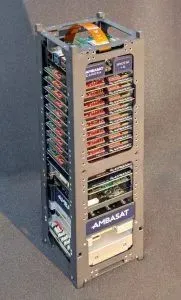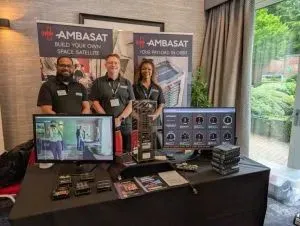The space education specialist designs and manufacture Low Earth Orbit (LEO) space satellite kits containing the components needed to launch experiments. And AmbaSat described the event as “a major milestone in our journey”, bringing together work across technology, regulatory and commercial domains.
 The platform was presented with fully populated flight trays with AmbaSat-1 ChipSats. The company said each one represented a real customer payload – sensors and components from universities and SMEs, for example. The company was also showcasing its AI camera integration, running on its modular flight tray system.
The platform was presented with fully populated flight trays with AmbaSat-1 ChipSats. The company said each one represented a real customer payload – sensors and components from universities and SMEs, for example. The company was also showcasing its AI camera integration, running on its modular flight tray system.
“[This was] part of our work exploring the future of onboard intelligence and image processing in orbit,” it said.
Starter kit
One satellite kit provided by the STEM specialist, for example, is the AmbaSat-1 STARTER Kit, for Low Earth Orbit comms.
It comes with an assembled satellite mainboard featuring the ATMEGA 328 microcontroller. There’s also a RFM95 LoRaWAN radio transceiver with a 700 kilometer+ range, gyroscope, accelerometer, magnetometer, capacitors, resistors, clock crystal, voltage regulator and LED.
The company writes:
“The AmbaSat-1 Kit also comes with your chosen sensor board (see below), 2xAA battery holder for portable power plus the FTDI programmer so that you can code your satellite directly from a Windows or Linux personal computer. Full example source code, step-by-step assembly guide and templates are also supplied.”
3U
A nanosatellite of one “unit” (1U) would typically be a cube with 10cm sides.
A 3U CubeSat simply combines three such units units, resulting in dimensions of 10cm x 10cm x 30cm. They typically weigh less than 1.33kg per Unit.
The 1U, 3U, and 6U are the most common CubeSat designs in use.
See also: Moonlighter CubeSat reaches orbit for sandbox in space hacking competition


